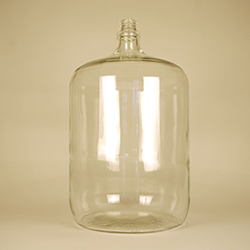The Glass Fortress: Fermenting Your Beer in Carboys
Posted by Matteo Lahm on 25th Apr 2023
If you are still using plastic fermenters and carboys for making beer, let’s talk about the sanctity of glass and why you might want to upgrade. In the realm of homebrewing, the quest for the perfect fermentation vessel is a tale as old as time. Let's explore the reasons why 6 and 6.5-gallon glass carboys are ideal for primary fermentation, and why the 5-gallon glass carboy is the go-to for secondary.
Your beer's well-being is of utmost importance, as it thrives in a pristine environment. The pH range of the brew can inadvertently create a playground for thrill-seeking bacteria, making the choice of fermentation vessel crucial. Glass carboys, in this regard, offer unparalleled sanitation and protection. The non-porous surface of the glass ensures that no microscopic invaders, such as bacteria and wild yeast, can breach its walls and compromise the quality of your beer.
In contrast, plastic fermentation vessels can harbor bacteria more easily due to their porous nature. Over time, scratches and imperfections can develop on the surface of plastic containers, creating tiny crevices where bacteria can hide and multiply. These hidden bacteria can be difficult to eliminate, even with thorough cleaning and sanitizing procedures. Consequently, the risk of contamination increases, potentially affecting the quality and taste of your brew during both primary and secondary fermentation.
Besides providing a reliable environment for fermentation, the transparency of glass carboys serves a practical purpose as well. It offers you a clear view of your beer's inner workings, allowing you to observe the fermentation process and the fascinating changes occurring within. This visual access is invaluable, as it enables you to identify potential issues and make informed decisions about the readiness of your brew for bottling or kegging.
While watching your beer ferment in a glass carboy, you can observe various stages and phenomena, such as the formation of krausen, the layer of foam that develops on the surface during active fermentation. Monitoring the rise and fall of krausen can help you determine the progress of fermentation and identify any potential issues, such as a stuck fermentation.
Additionally, you can keep an eye on the clarity of your beer, which can indicate whether it's time to move on to the next stage of the brewing process. If you notice excessive sediment or cloudiness, it may signal the need for additional clarification steps or an extended period of secondary fermentation.

Furthermore, the transparency of glass carboys allows you to spot any signs of infection or contamination, such as unusual colors, or unexpected surface formations. Early detection of these issues can help you take corrective measures and potentially save your brew from ruin.
When it comes to primary fermentation, 6 and 6.5-gallon glass carboys are a great choice for fermenting 5-gallon batches. Their larger size provides ample headspace for the vigorous fermentation activity that occurs during this stage, preventing overflow and ensuring a smooth process. The thick walls of the carboy also provide excellent insulation, maintaining a stable temperature throughout the primary fermentation process. Consistent temperature control is crucial for preventing off-flavors and ensuring the best possible taste for your beer.
For secondary fermentation, the 5-gallon glass carboy is the standard choice. Its slightly smaller size is ideal for the more subdued fermentation activity that occurs during this stage, allowing you to separate the beer from the sediment and clarify it before bottling or kegging.
In terms of durability, glass carboys are built to last. While the initial cost may be higher than plastic alternatives, the longevity of a glass carboy makes it a worthwhile investment. With proper care, a glass carboy can serve as a long-lasting companion for your homebrewing endeavors.
However, every hero has its Achilles heel, and the glass carboy is no exception. Its weight and fragility demand that you handle it with care, lest it shatter and bring your brewing dreams crashing down. But fear not, for with proper handling and the use of carboy handles or carrying straps, you can mitigate these risks and harness the power of the glass carboy with confidence.
In conclusion, glass carboys offer numerous advantages for both primary and secondary fermentation in beer making. Considering the ever-present menace of bacteria, it is one of the best insurance policies you can have for your batches. And it is not just the cost of your materials, it is your time and hard work. By carefully selecting the appropriate size for each stage and handling your glass carboy with care, you can enjoy the benefits it provides and produce high-quality beer for years to come.


